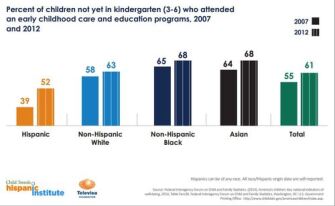Latino children continue to trail their non-Latino peers on many measures of academic success, but a new study shows they are gaining ground.
The share of Hispanic children attending a center-based, early-childhood education program increased by one-third between 2007 and 2012, while the percentage of Hispanic 8th graders scoring proficient or better on national mathematics exams rose from 8 percent in 2000 to 21 percent in 2014.
And while dropout rates for Hispanic students remain high, the share of Latino youth ages 16-24 who did not graduate from high school has declined from 29 percent in 1999 to 13 percent in 2012.
Those outcomes, among others, show a promising trend of educational improvements for Latino youngsters—who are the largest racial/ethnic minority group of children in the United States, according to a new analysis from Child Trends Hispanic Institute.
Hispanic children are also the fastest-growing group of young people in the United States—growth that has fueled a significant shift in public school demographics over the last 20 years. For decades, Hispanic students have lagged behind their non-Hispanic white peers on most measures of educational success, and have trailed their African-American peers in some areas.
Though they have made important strides in preschool participation in recent years, Latino children still remain the least likely among their peers in other ethnic groups to take part in early-childhood programs that help prepare youngsters with the knowledge and skills they need for school. More specifically, they trail their non-Hispanic white and black peers when it comes to school-readiness skills such as letter recognition and the ability to count to 20 before entering kindergarten.

The new report also looks at how Hispanic children are faring on measures of health, family, the economy, and media use. Among the highlights in those areas: Hispanic children still face high poverty rates and high rates of teen childbearing, but they are more likely than any other peers to eat frequent family meals, far outpacing the rate for non-Hispanic white and African-American children.
Child Trends will host a webinar on the new report Thursday at 1 p.m. EDT.



